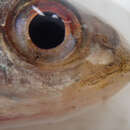pms
nòm ant ël fil


Die Rooi-ghieliemientjie (Barbus fasciolatus) is 'n varswatervis wat voorkom in die Kunenerivier, die Okavangorivier, die boonste en middelste gedeelte van die Zambezirivier, die Kafuerivier en die Zambiese gedeelte van die Kongorivier. In Engels staan die vis bekend as Red barb.
Die vis is ligrooskleurig aan die bokant en silwerwit aan die onderkant. Daar is 10-15 vertikale strepe op die lyf. Die tweede of derde streep is breër as die res terwyl die laaste streep meestal 'n kol op die basis van die stertvin is. Die lyf is slank en daar is twee pare baarde om die bek en die vis word tot 60 mm lank.
Die vis leef in suurstofryke water vol plantegroei soos in strome op vloedvlaktes en permanente mere. Die vis is sku en meer aktief in die oggend en laatmiddag. Hulle vreet klein organismes, partykeer van plantoppervlaktes af.
Die Rooi-ghieliemientjie (Barbus fasciolatus) is 'n varswatervis wat voorkom in die Kunenerivier, die Okavangorivier, die boonste en middelste gedeelte van die Zambezirivier, die Kafuerivier en die Zambiese gedeelte van die Kongorivier. In Engels staan die vis bekend as Red barb.
Die Angolabarbe (Enteromius fasciolatus, Syn.: Barbus fasciolatus, Barbus bariloides Boulenger, 1914), auch Blaustrichbarbe, Rotflankenbarbe oder Tigerbarbe genannt, kommt im südlichen Afrika im Kunene, Okavango, im oberen und mittleren Sambesi, im Kafue, im oberen Kongobecken (Luongo, Luapula), in den Bangweulusümpfen und in der Kariba-Talsperre vor.
Die Angolabarbe wird 5 bis 7 cm lang und hat eine gattungstypische, langgestreckte, seitlich abgeflachte Gestalt. Weibchen sind deutlich kräftiger, Männchen schlanker. Ihr Rücken ist bräunlich bis graugrün, die Körperseiten sind orange bis rötlich und mit 12 bis 16 schmalen, dunklen Querstreifen gemustert. Das Art-Epitheton fasciolatus bedeutet „fein gestreift“. Der dritte und der letzte können zu einem Fleck verbreitert sein. Der Bauch ist weißlich, die Flossen sind gelblich, die Rückenflosse trägt einen karminroten Fleck. Junge Weibchen sind häufig tintenrot. Die Schwanzflosse ist gegabelt. Ihre Seitenlinie ist vollständig. Die Angolabarbe besitzt zwei gleich lange Bartelpaare.
Sie bewohnt sauerstoffreiche, gut bewachsene Gewässer und ist scheu. Ihre Hauptaktivitätszeit ist der frühe Morgen und der späte Nachmittag. Die Angolabarbe ernährt sich von Würmern, Krebstieren, Insekten und pflanzlichem Material. Beim Laichen geben die Weibchen 150 bis 200 Eier ab. Die Jungfische schlüpfen temperaturabhängig nach etwa 50 Stunden, schwimmen nach weiteren 3 bis 4 Tagen frei und können schon nach 6 Monaten ausgewachsen sein.
Die Angolabarbe (Enteromius fasciolatus, Syn.: Barbus fasciolatus, Barbus bariloides Boulenger, 1914), auch Blaustrichbarbe, Rotflankenbarbe oder Tigerbarbe genannt, kommt im südlichen Afrika im Kunene, Okavango, im oberen und mittleren Sambesi, im Kafue, im oberen Kongobecken (Luongo, Luapula), in den Bangweulusümpfen und in der Kariba-Talsperre vor.
The African banded barb, Angola barb, blue-barred barb or fire barb (Enteromius fasciolatus) is a ray-finned fish species in the family Cyprinidae.
It is found mainly in Angola and Zambia, extending into neighboring Botswana, the Democratic Republic of the Congo, Namibia and Zimbabwe.[2]
Its natural habitats are the upper and middle Zambezi River, the Cunene and Kafue Rivers, the Luapula River and Lake Mweru, the Okavango River, Lake Kariba, and the Zambian Congo River, as well as some of their tributaries.
This species is an aquarium fish of some importance. Lively and peaceful, it does not thrive in high water hardness and needs to be kept in groups.
The African banded barb, Angola barb, blue-barred barb or fire barb (Enteromius fasciolatus) is a ray-finned fish species in the family Cyprinidae.
It is found mainly in Angola and Zambia, extending into neighboring Botswana, the Democratic Republic of the Congo, Namibia and Zimbabwe.
Its natural habitats are the upper and middle Zambezi River, the Cunene and Kafue Rivers, the Luapula River and Lake Mweru, the Okavango River, Lake Kariba, and the Zambian Congo River, as well as some of their tributaries.
This species is an aquarium fish of some importance. Lively and peaceful, it does not thrive in high water hardness and needs to be kept in groups.
Barbus fasciolatus es una especie de peces de la familia de los Cyprinidae en el orden de los Cypriniformes.
Los machos pueden llegar alcanzar los 6 cm de longitud total.[1][2]
Es un pez de agua dulce.
Se encuentra en el lago Kariba y los ríos Zambezi y Okavango (África Austral ).
Barbus fasciolatus es una especie de peces de la familia de los Cyprinidae en el orden de los Cypriniformes.
Barbus fasciolatus Barbus generoko animalia da. Arrainen barruko Actinopterygii klasean sailkatzen da, Cyprinidae familian.
Barbus fasciolatus Barbus generoko animalia da. Arrainen barruko Actinopterygii klasean sailkatzen da, Cyprinidae familian.
Barbus fasciolatus, conosciuto comunemente come barbo striato africano, è un pesce d'acqua dolce appartenente alla famiglia Cyprinidae.
Questa specie è originaria delle acque dolci africane dei bacini idrografici dei fiumi Okavango, Zambesi (e relativo lago Kariba), Cunene, Congo, Luongo e Bangweulu. Abita acque molto vegetate e ben ossigenate, ma tranquille (preferendo canali, rive e lagune) spesso muovendosi sul fondo ma emergendo all'improvviso in superficie e in gruppo all'alba e al tramonto. Durante la stagione delle piogge effettua migrazioni.
Presenta un corpo allungato, con profilo dorsale convesso. Gli occhi sono grandi con iride rossi, il peduncolo caudale è affusolato. Le pinne sono arrotondate, la coda bilobata. La livrea varia dal rosa al bruno-rossastro, con dorso più scuro e ventre bianco argenteo. Lungo i fianchi vi sono 11-13 fasce nere verticali. Le pinne sono rossastre. Raggiunge una lunghezza massima di 6 cm.
Il Barbus fasciolatus è un pesce che vive in gruppo.
Si riproduce deponendo e fecondando le uova in una zona tranquilla e ricca di vegetali.
Commestibile, anche se non ha valore commerciale.
Barbus fasciolatus ha dieta onnivora: si nutre prevalentemente di vegetali (alghe e detriti di piante acquatiche) ma non disdegna piccoli invertebrati acquatici
Non è una specie commerciata con assiduità in Italia, è presente occasionalmente nei negozi di acquariofilia.
Barbus fasciolatus, conosciuto comunemente come barbo striato africano, è un pesce d'acqua dolce appartenente alla famiglia Cyprinidae.